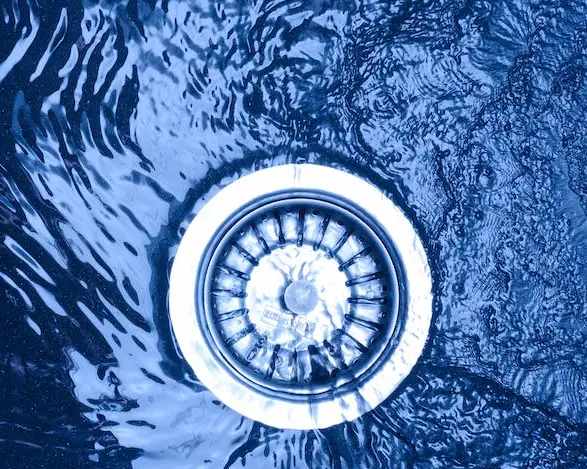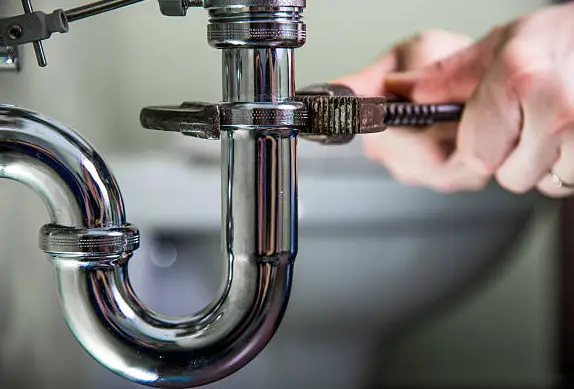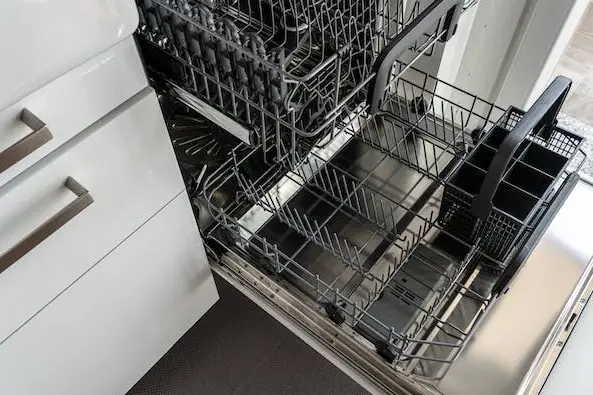Your all-well and invaluable cleaning master has stopped draining! The machine causes water to stand, plus your kitchen has unpleasant odors. Also, your dishes come out dirty. Your kitchenAid dishwasher not draining is quite frustrating and disruptive. You have to undo your daily routine to clean the dishes. However, you can apply a few fixes to resolve the problem.
KitchenAid dishwasher not draining has to do with a clogged drain filter, blocked drain hose, faulty drain pump, and blocked air gap. A drainage system obstruction also causes a backflow. This comprehensive guide will explore the common causes behind this problem and provide step-by-step troubleshooting instructions. We will help you resolve the issue and restore your KitchenAid dishwasher to optimal performance.
1. Clogged Drain Filter

Your KitchenAid dishwasher won’t drain because of a clogged filter. Over time, the unit’s filter traps and accumulates food particles, debris, and other objects. The muck inhibits water flow and causes drainage issues. That’s why dishwasher makers recommend that you pre-rinse your dishes in a basin of water before putting them in a dishwasher.
When you clean the filter, you eliminate food debris, toothpicks, bones, and other objects that might choke your drain filter. Now that your kitchen aid dishwasher is not draining, you must check and fix this filter.
Fix
To fix a clogged drain filter, you will need a soft brush, an old toothbrush, and a basin of clean water or running tap water. Here are the steps to fix a clogged drain filter;
- Locate the filter at the bottom of your KitchenAid dishwasher.
- Pluck the filter cover.
- Clean the filter under running water. A soft brush or an old toothbrush can help scrub the debris off the filter.
- Reinstall the filter and secure the cover back in place.
- If the filter is old and damaged, you can replace it. Ensure that you order from a trusted KitchenAid dishwasher parts dealer or manufacturer.
- As a part of regular maintenance practice, inspect your drain filter regularly, clean it, and replace it where applicable.
2. Blocked Drain Hose

A blocked drain hose is another cause for the KitchenAid dishwasher not draining. So, if you have resolved the filter but the problem continues, it is time to check this pipe. The drain hose carries water from the dishwasher to the sink’s plumbing system. It can become blocked or kinked, impeding water flow and causing poor drainage. So, you need to inspect it and fix the issue.
Fix
The KitchenAid dishwasher not draining after cycle will require these straightforward steps to fix. You will need a long flexible brush or a pipe cleaner to remove debris or objects.
- Disconnect the drain hose from the dishwasher.
- Inspect if there are any blockages, kinks, or obstructions.
- If there are any, use a long, flexible pipe cleaner to remove any debris.
- Straighten any kinks and check for breakages.
- If there are cuts, you need to replace the drain hose. Ask your dealer to replace it for you.
- Reconnect the drain hose securely, ensuring there are no kinks or bends.
- Inspect your drain hose regularly to get hold of any damages and resolve them before a drainage issue occurs.
3. Air Gap Blockage
Your KitchenAid dishwasher will not drain if there is an air gap blockage. (I assume your model has an air gap, as most dishwashers have one). The device prevents dirty water from flowing back into the dishwasher. So, a backflow of dirty water from the plumbing drain will happen without the air gap or a blocked one.
If the air gap becomes clogged with debris or food particles, it can obstruct water drainage. Hence the KitchenAid dishwasher is not draining. If you have tried all the other tricks and none seems to enhance your dishwasher drainage, you must access the air gap, inspect, and fix if there are issues.
Fix
- Locate the air gap, typically installed on the countertop or sink.
- Remove the air gap cover and inspect it for blockages.
- Use a small brush to remove any debris or food particles.
- Rinse the cover thoroughly and reinstall it securely.
- If your dishwasher’s air gap is worn out, you must replace it. Ask your point of contact to deliver the exact model for the correct match.
4. Faulty Drain Pump
The drain pump ensures that all the dirty water comes from your dishwasher when your utensils are clean. If the pump operations are defective, the process will be slow or will stop. That causes drainage problems. The pump is motor-driven and might require an expert to inspect and repair it. However, if you are a DIY enthusiast, you can refer to your KitchenAid dishwasher user manual or try the following steps;
Fix:
- Disconnect the power supply to the dishwasher.
- Locate the KitchenAid dishwasher drain pump at the bottom of the unit.
- Once you access it, remove the cover or housing.
- Check for debris or blockages.
- Clear the blockage using a small brush or toothpick.
- Ensure that the impeller moves freely.
- If damaged or obstructed, it will need a replacement. Call your dealer or KitchenAid dishwasher company for pump replacement.
- If your pump is sound, reassemble the cover or housing, ensuring proper sealing.
- Plug and run your dishwasher to see if it works.
5. Blocked Garbage Disposal

Your dishwasher and the garbage disposal work hand in hand. So, a clogged disposal unit can cause the dishwasher water not to drain and vice versa. However, you ought to be careful when handling your garbage disposal as you can mess it up and end up with costly repairs. In this exercise, you will need tongs to remove objects from the garbage disposals.
Fix
- First, unplug both units for safety.
- Next, check if your plumber removed the drain plug from the hose during installation. Most installers omit this process, which later causes a blocked drainage. If not so, continue with the below steps.
- Remove your KitchenAid dishwasher’s drain hose.
- Remove any debris or objects on the disposal’s fittings and the hose.
- Clear the objects from the garbage disposal using tongs. The debris includes broken glass, melamine, plastics, bones, metallic and wooden objects.
- You can use an Allen wrench to maneuver inside the grinder to stir and break any objects in the unit.
- For any challenging procedure involving your two units, call your plumber.
6. Drainage System Obstruction
Finally, your KitchenAid dishwasher does not drain because the drainage system may be obstructed. Unlike most of the causes and fixes we have detailed, the drainage is external, and dishwasher. To resolve the issue, you must inspect and work on the unit. But that may not yield any fruits. The cause might be external to your machine. In some cases, the primary drainage system of the dishwasher may have an obstruction, preventing proper water flow and causing drainage issues. A blocked drainage system may be complex or easy to resolve, depending on where the blockage is. That’s why we might recommend a plumber at the end of the steps below. So, follow the steps below, and feel free to call for professional assistance if your efforts are fruitless.
Fix
- Consult the owner’s manual for instructions on accessing the primary drainage system.
- Inspect the system for any obstructions or blockages, removing them carefully.
- Follow the manual’s guidance to reassemble the drainage system correctly.
- If the above fixes do not resolve the problem, or if you are unsure about performing the troubleshooting steps yourself, you should seek professional assistance from a qualified technician or plumber. They can diagnose and repair more complex issues within the dishwasher’s drainage system.
Frequently Asked Questions
Q: Why is my KitchenAid dishwasher not draining?
A: Your dishwasher is not draining due to a faulty drainage system, clogged filter, blocked air gap, or an obstructed drain hose. To resolve the issue, follow our DIY steps to unclog the crucial components or call a plumber to tackle the complex processes.
Q: How do I force my KitchenAid dishwasher to drain?
A: Access your drain hose and place it in an empty bucket. Press your dishwasher’s drain/cancel/start knob for three moments to force-drain the unit. Close your dishwasher door for it to start. Shake the drain tube in the bucket to remove the blockage.
Q: Why does my KitchenAid dishwasher have standing water?
A: Your dishwasher can hold a little water in the filter area. The water keeps the seals moist. While the sanding water is expected, the water should not be in excess or smell. If it is a lot and smelly, the issue could be a blocked drainage. Unblock a clogged filter, air gap, and drain hose. If it is complex for you, call a professional for help.
Q: What is the leading cause of the KitchenAid dishwasher not draining?
A: The leading cause for the KitchenAid dishwasher not draining is blockage. It could be the filter full of debris, or the drain hose is kinked or blocked. You can undo this issue by inspecting and unclogging the various components that enhance smooth draining in your dishwasher.


